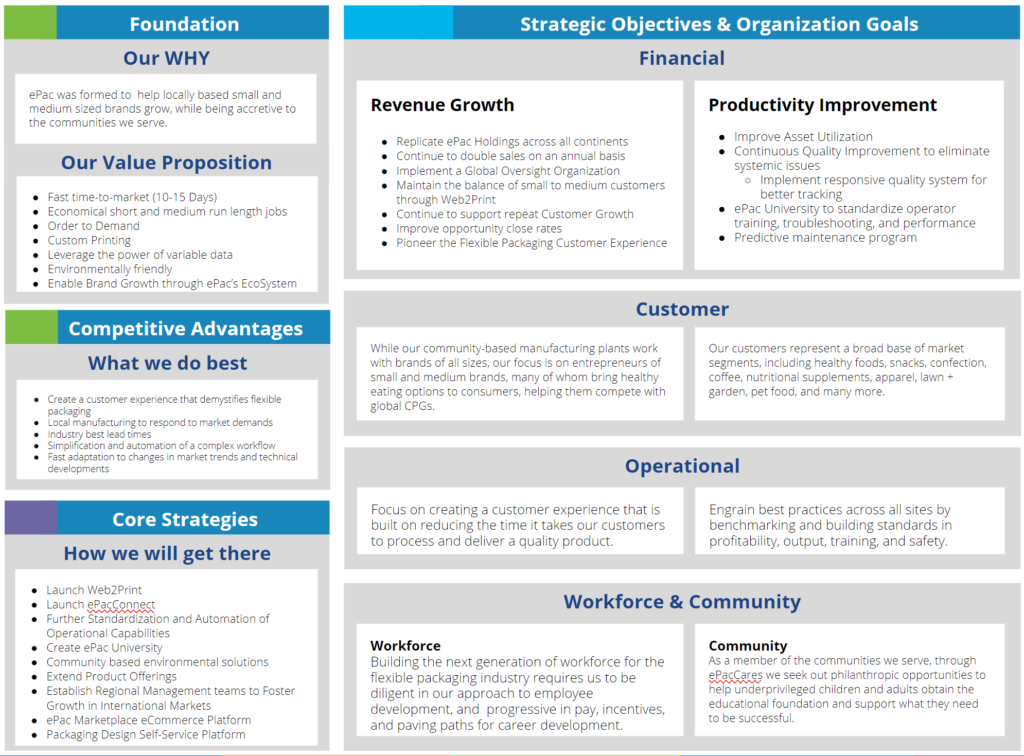
After many years playing a role in the consolidation of an industry, working with large entities managed by executives schooled in traditional business methods, it’s apparent that the continued growth of established businesses has become limited by the main value generator and the ability to adapt has been halted by internally created guardrails.
In any industry, this type of internal complexity stifles growth and the only way that industries are able to move forward is based solely on underlying industry dynamics.
The Flexible Packaging industry in North America and Europe is where the consolidators grew to a point that they mainly service large global consumer packaged goods (CPG) companies and the residual companies that were not consolidated are unable to adapt to the needs of the new market dynamics.
Global Market Size (2019) – $92.7B*
- Asia Pacific – 44%
- NA – 28%
- EU – 18%
- Middle East/Africa – 5%
- South/Central America – 5%
*Source: Flexible Packaging Assoc.
Instead of taking a traditional approach of putting together a business plan, determining which problem would be solved, doing a market analysis on the current state of the industry, defining our competitive advantages, and projecting financials to get financing, we decided to take a very unique approach with ePac. This unique approach was inspired by Biomimicry.
Biomimicry or Biometrics is an innovative concept for complex problem solving inspired by nature and its elements.

A great example of biomimicry can be found in ancient architecture. For years, architects have used dendriform technology, which is inspired by trees. Dendritic structures and arboreal architecture were present in cave drawings, used by the Greeks for column structures, and in later years, 771 BC to 476 BC, in dougong construction. With dougong construction, wooden brackets are interlocked, serving as a structural component.
This is called fractal generation or IFS. In the 20th century, it was also used in the design of reinforced concrete structures.

ePac is like a tree. Why a tree? Primarily because they are complex and fractal-like. Trees have a set of physical, mechanical, and biological functions.
Fractal-like or self-similarity, nature, implies that there is a strong correlation of the shape and patterns of the natural object and its biological form and mechanical properties. For example, fractal-like branching, when looked at from the different angles of biological, structural, and mechanical needs, shows the inherent rationality of its shape and form.
The biological needs of sun and rain is balanced with the structural needs of resistance to strong winds which is balanced with the mechanical needs of height and breadth.
In other words, the shape is formed from the combination of these three needs.
When we look at a consolidated industry like flexible packaging, and the large entities that have formed, there is an obvious need that is not being fulfilled. In this case, that need was to support small to medium sized businesses seeking professional-looking, affordable flexible packaging that helps them quickly grow their business.
Instead of trying to recreate the current entities and fight for the same resources they require due to their size, we decided to plant a seed and allow it to grow with a multi-faceted approach which balances the needs of the market (biological), the needs of investors (structural), and the needs of the operations (mechanical). Whether that seed grew into a mega plant, a virtual plant, a technology company, or a broker, we did not care, we were going to follow the natural growth given the balance required between the community of small businesses, the Investors, and the operations. We came to market with a value proposition that would create a solution to a problem, no business plan, no go to market strategy, no financial expectations and no long term goals.

So the growth began. For a startup, the first investors were only interested in a minimal amount of cash in. Our first customers were local small businesses that were looking for a packaging partner to solve their problems. Our team of operators worked as a well oiled machine to meet the promises we made to our customers. Just like a tree grows, we started to branch out to new geographies to balance the customer exposure and complexity and not increase the financial risk of the original investors. As new needs arose, we adapted from the enterprise resource planning (ERP) systems to new algorithms for fast pricing models to new lead generation methods to audited financials. By growing this business model along a simple replication process, addressing new needs as they arose, and maintaining the balance through compromises, we created a global footprint without the inherent risks associated with a traditional business model.

This serves as an introduction to our Strategic Plan. It is difficult to plan within calendar years the needs which may arise and when we mitigate or solve those needs. In the Strategic Plan below, you will see the underlying balance continue: deliver to the market the new technologies required by small businesses to compete and grow (connected packaging, web to print solutions and a broader product breadth), the new technologies to allow operations to continue to sustain the value proposition (ePac University for training, increased number of plants and improved standard operating procedures), and the new financial expectations (updated financial models, improved bank lending facilities, and flexible capital structures).
In the end clouds are not spheres, mountains are not cones, and lightning does not travel in straight lines, therefore, ePac is not a traditional business and will not follow a predetermined strategic plan.


